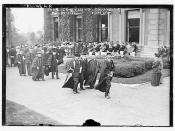Davidson and Lytle pose an interesting question about racial and class perceptions in their chapter entitled "The View from the Bottom Rail." Seeking to demonstrate that our understanding of what it meant to be a slave is far from complete, they ask the reader to consider context, expectation, and caste in order to arrive at a more complete understanding of the "peculiar institution." This social history attempts to supplement, and perhaps even refashion, our understanding of slavery.
One of the first elements of their analysis is to focus on nontraditional subjects. Historians have so often used members of the highest social classes to inform their work that the result was patently one-dimensional. This bias was in large part due to the production of primary sources; so called "bottom railers" did not leave much by way of written or documentary evidence for the researcher to consider in her analysis. Our understanding of slavery has come largely from white accounts.
It is easy to see how this understanding could be skewed, as the authors' use of the Squires Jackson example so clearly suggests. Simple survival dictated that slaves would mislead masters. Beliefs in white superiority meant that masters would manufacture a reality rather than accept actions that challenged it. The authors provide ample materials, both primary and secondary, to demonstrate the white view of slavery.
The development of oral history during the Great Depression offered great hope to historians that a corrective to the white/class bias of the past had been found. The Federal Writers' Project included a section whose task was to interview former slaves. Here, at last, was the word of slaves about their condition: The American Slave: A Composite Biography filled nineteen volumes.
But Davidson and Lytle suggest that thre are a number of methodological concerns that should cause...

![Laying cornor [i.e., corner] stone, Columbia. Pres. Butler & Dean Wheeler (LOC)](https://s.writework.com/uploads/13/133219/laying-cornor-e-corner-stone-columbia-pres-butler-dean-wheel-thumb.jpg)
